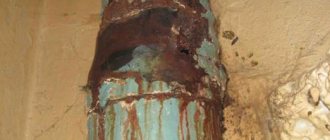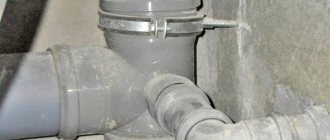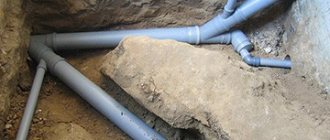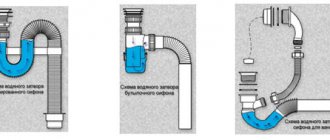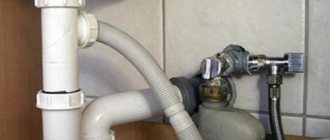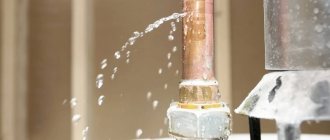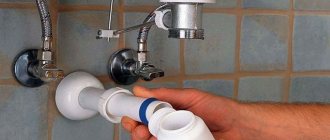It's nice to start the morning in a lovingly furnished kitchen, drink your first cup of coffee and enjoy its taste and aroma. And it’s a completely different thing to go out in the morning in your pajamas and smell a pungent smell coming from the sink that has managed to permeate all your favorite textiles: curtains, towels, rugs. How to determine the cause and how to eliminate the smell from the kitchen sink? We will tell you about this in this article.
You will learn about the possible causes of smell from the sink, how to remove them and prevent further occurrence. It is very important to destroy the sewer spirit, because it is impossible to enjoy cooking and eating food in a room permeated with aromas that do not increase appetite.
Let's look at the reasons for the appearance
There are several reasons why your kitchen sink may smell like sewer or other unpleasant odors:
- rare use of this sink . To prevent bad smells from penetrating from the sewer, there is clean water in the water seal in the bend of the siphon. When you don’t turn on the water for a long time, this area dries out (the water from the water seal evaporates), all the unpleasant odors freely penetrate into the room;
- Siphon clogged . When the sink is used intensively, small amounts of food, grease, and other substances inevitably end up there. This all partially settles on the elements of the sewer system, after some time it begins to rot, and a heavy smell spreads throughout the room;
- airing of the riser . This option is characterized by gurgling sounds. This is a defect in the main sewer system, it is necessary to invite plumbers, but cannot be eliminated by ourselves;
- poor-quality sealing of the joint between the riser and pipes . Often this is precisely the problem that leads to such unpleasant consequences;
- unprofessional siphon installation . If the installation of the siphon is carried out by illiterate specialists, the water seal does not cope with its task of isolating odor. You should reinstall the siphon yourself or by inviting highly qualified plumbers;
- The corrugated pipe has lost its shape . It may become deformed over time, which may also be the cause of this problem. In this case, it should be replaced.
We draw your attention to the fact that the smell does not always come directly from the drain hole; there may be microcracks or chips in the pipes, water can ooze, be absorbed into the finishing materials, evaporate, and an unpleasant spirit will hover in the space.
Not only unpleasant, but also harmful!
The point is not only that the heavy sewer spirit is unpleasant to all household members, it is also harmful. Human evolution has made sure that he can recognize odors that threaten his health. And a sharp, repulsive smell signals us about danger; we should not distrust our instincts.
Let's try to figure out why the smell from the sink is harmful? The air from the sewer, which enters our premises and causes our rejection, is poisonous. It contains hydrogen sulfide and ammonia fumes. During decomposition processes in the sewer system, methane is also formed, which also does not contribute to human health.
Together, these substances - methane, ammonia and hydrogen sulfide - negatively affect human health. Through the respiratory system they depress the central nervous system. In severe cases, they provoke nervous breakdowns and brief loss of consciousness.
Therefore, we strongly recommend removing the unpleasant smell under the sink as soon as you notice it!
Watching the car wash
In some cases, you can deal with the bad smell from the sewer on your own. Let's figure out when you can do without calling a specialist from technical services.
First, let's watch the washing machine in action. You should pass a large volume of the hottest water possible; if it flows well, does not stagnate, but the smell does not become weaker, try flushing the drains with home remedies (recipes are given below in the article) or products containing aggressive chemical compounds.
If the problem is deposits and fat that have begun to emit a putrid odor, then you can deal with it.
If cleaning the pipes did not help, then we will carefully examine the siphon and the pipes underneath it. All parts of the sewer system must be dry; if there is a leak somewhere, it must be repaired.
The pipes must be intact, without chips, all connections must be free of wet marks. There is a mess - fum or plumbing sealant will come to the rescue.
Plumbing sealants that are suitable for the kitchen:
- acrylic;
- silicone;
- silicone-acrylic.
The most popular are silicone sealants , they are optimal for the kitchen - they have excellent bonding properties, withstand temperature changes, and retain moisture well. The disadvantages include the cost of the product.
Acrylic sealants are durable and more affordable, but due to their lack of elasticity, seams can become depressurized over time. Therefore, it is better to choose another option, or to vigilantly monitor the condition of all sewerage elements.
Silicone-acrylic sealants , as the name implies, combine the best qualities of the above sealants.
If we open the tap and observe, we will notice that the water is slowly draining, standing in the sink, and we have a blockage.
Violation of tightness
At the junction of the siphon and the pipe, a leak is often observed.
The occurrence of this problem is quite easy to determine (unlike blockages or internal breakdowns), since the result will be drips. If the problem has not been resolved at the time of its occurrence, these leaks cause a stench from the sink, the appearance of fungus and mold on the walls and floor. This happens when the seals are worn out or deteriorated. A temporary solution can be a special sealing tape or electrical tape, but new seals will help to finally solve the problem. If a leak occurs between pipes, then it is necessary to coat their joints with silicone sealant.
How to deal with clogs
Various food debris, hair, and grease form a plug in the sewer, which prevents water from flowing normally and emits a strong, unpleasant odor.
There are several ways to remove smell from your kitchen sink:
- clean with a plumbing cable,
- using a plunger,
- by manually disassembling the siphon and subsequent cleaning of all its elements.
Let's consider all these options in more detail.
Cleaning with a plumbing cable
This cable can be purchased at hardware and construction stores. Cleaning a pipe using a plumbing cable is quite simple and does not take much time. It is a dense and flexible metal spiral that can penetrate into all bends of the water pipe.
It is important to be careful, especially when draining plastic - sudden and too strong movements can damage the pipe. The process itself is extremely simple:
- Push the cable into the pipe with screwing movements as deep as possible.
- Gently pull towards yourself to catch all the debris that has clogged the drain.
- Run a thin stream of water to remove any remaining grease.
If the water begins to drain well, then the problem is solved. After this, you need to turn on a strong pressure of hot water and wait a couple of minutes.
Lifehack! If you don’t have a special cable at hand, you can make an analogue with your own hands. To do this, you will need a 1.5–2 liter plastic bottle, on which you need to draw a strip 1.5–2 cm wide in a circle and then cut it out. Notches are made along the perimeter of the resulting strip so that cleaning the drain is most effective.
Cleaning with a plunger
The plunger can be called a magic wand that helps out at the most necessary moment, namely, it overcomes blockages. And not only in the kitchen, but also in the bathroom, and even in the toilet. Of course, it is better to use separate devices for different purposes.
There should be a separate plunger for the kitchen sink (for the toilet room, therefore, also a separate one).
It can also be purchased in stores, it is very simple to use and does not require any special skills.
It is able to quickly remove small blockages due to a simple principle of operation: creating a hydraulic column that pushes contaminants further along the pipe with pressure, freeing the drain.
It's even easier to use than a plumbing cable:
- Press the rubber band onto the drain.
- Press with force.
- Pull up sharply.
- Repeat several times.
- Run a thin stream of water to check.
After cleaning with a plunger, also open the hot water tap to complete the drain cleaning properly.
Secret! If the sink consists of two or more sections, then the necessary pressure simply will not appear. To clean you will need:
- or use several plungers for each drain hole;
- or simply plug the “unnecessary” holes with a damp cloth.
Cleaning the siphon manually
If you need to carry out a major cleaning due to a large blockage, it will be effective to disassemble the siphon and manually thoroughly clean all its elements. Of course, this is not the cleanest work that creates appetite and improves mood, but it is a very effective way to cope with the problem.
The siphon must be disassembled, cleaned and thoroughly washed all its parts, then carefully put back together. At the beginning of work, place a bucket or basin under the sink, water from the water seal will drain there.
DIY crafts
There is another operating principle that can be tested in the fight against blockages and unpleasant odors - hydrodynamics. This is a method of exposure using a powerful jet of water. Special devices for this have long been invented, but they are found only among professionals due to their high cost.
But you can create a similar unit with your own hands. For this you will need:
- thin garden hose;
- thin nail;
- blowtorch (or at least fire from a gas burner).
Below you can see a professional tool. You can do something similar with your own hands.
The manufacturing process itself is very simple, but requires care:
- Cut off a piece of hose.
- Seal it at one end as tightly as possible.
- Heat the nail and make several holes at a distance of 10 cm from the soldered end.
- Connect the unsoldered end to the tap and secure.
- Place the sealed end into the drain.
- Turn on the water under high pressure.
Water should fly out of the holes with force and destroy the coating on the pipes. After the procedure is completed, the hose is removed and the drain is washed with a stream of hot water for five minutes. A clean drain will ensure that there is no smell from the sink.
Basic methods of disposal
The solution to the problem will depend on the provoking factor. If the cause is determined correctly, then eliminating the unpleasant odor will not be difficult.
Drying humid environments
When purchasing an air conditioner, it is recommended to pay attention to models that have a delay function for turning off the fan after the device has already been turned off. This keeps the evaporator dry and prevents the creation of a high humidity environment and unpleasant odors.
If the air conditioner does not have such a function, then this procedure can be done independently. It is necessary to manually turn on the ventilation for 3-5 minutes and only then turn off the device. If installation is incorrect, you can only get rid of the smell and moisture by reinstalling the system.
Treatment
It is recommended to clean the air conditioner regularly to prevent dirt from accumulating inside the device.
Particular attention is paid to hard-to-reach places - the evaporator, since fungi and bacteria most often accumulate there
Specialists clean these areas using gas and foam. The method is not as effective as manual cleaning, but it helps to cope with the unpleasant odor. The most common means of treatment are gas, foam, liquid antiseptic and hand washing.
Gas
In order for disinfection with this type of antiseptic to give the desired result, preliminary preparation is required:
- turning on air circulation;
- An antiseptic cylinder is activated near the air intake hole and the room is closed for 10-15 minutes;
- airing the room.
This method is considered the simplest and less effective, so you should understand that after some time the device has been in operation, the smell will appear again.
Foamy
In this case, a balloon filled with foam is used, which must be released inside the device onto the ventilation and air conditioning elements. Then the air conditioner turns on, the heating of which causes the foam to expand and penetrate into hard-to-reach places. It will settle within 15-20 minutes.
This processing method is considered more effective than the previous one. The product penetrates inside the device, thereby killing pathogenic microorganisms. But there are cases when this method does not give the desired result.
Liquid
Special products are used to treat the air conditioner with liquid antiseptics. Do not use household chemicals, as they can harm the device. Special solutions help fight fungi and bacteria without harming the elements of the device.
The treatment is carried out with a spray gun, paying attention to the air duct channels and the air conditioning system. Vapors of the product are sucked in through the air intake when the device is turned on.
The solution will be ineffective if you do not first clean the inside of the air conditioner.
Manual flushing
This method is considered the most effective in combating unpleasant odors. The system is completely disassembled and cleaned. This will require professional help. The process will take a lot of time, but the guarantee of achieving the result will be 100%.
Installation of antibacterial filters
A universal solution to the problem is the installation of antibacterial filters. They help fight unpleasant odors and pathogens.
Photocatalytic
This type of filter is considered absolutely safe for humans. It absorbs any organic odors. It is based on titanium dioxide.
Plasma ionizer
The filter is made of metal plates, the voltage between them is several thousand volts. A big plus is that it does not require periodic replacement of internal filters.
Catechin
The filters contain a natural antiseptic - catechin, which prevents viruses from attaching to the surface, as it envelops them. Considered safe and effective.
If you rarely use the sink
It happens that at a certain period of life the kitchen sink is rarely used, the water in the water seal evaporates, and the kitchen is filled with a pungent sewer spirit. Or, for example, people come to their country house only on weekends, and it’s not pleasant to immediately experience negative emotions because of this problem.
If you live in a house that doesn't use the sink much, just turn on the faucet periodically and let the water run for a while, cold or hot doesn't matter.
If you leave the house for a long time, the water has time to dry, your task is to prevent drying out. Let's remember physics lessons. Oil will come to our aid; it is lighter than water, will spread like a film and will not allow evaporation to occur. You can use whatever oil is on hand - vegetable oil, or you can add a little machine oil.
Use of chemicals and home remedies
They say that there is no such problem in home cleaning that soda, lemon (citric acid) and vinegar would be powerless to solve. They can remove old stains, make windows and mirrors shine, keep home appliances clean, and also eliminate strong odors from sink overflows.
Having this simple and inexpensive set of tools, we can begin to remove the blockage, the result for us will be the desired freshness and cleanliness in the house.
Lemon acid
You can clear a small blockage with a pack (100 g) of citric acid:
- Pour the pack into the sink, add a little boiling water, and plug the drain hole with a stopper.
- Leave for half an hour, then run hot water to complete the cleaning.
Citric acid is a versatile item in the kitchen. With its help, you can easily get rid of stains on a towel or descale a kettle.
Soda+vinegar
Soda, like vinegar, has an antibacterial effect, that is, it kills the very cause of the unpleasant odor - bacteria. This cleaning can be carried out even after treatment with a plunger to achieve maximum effect.
There is also an option for cleaning the drain using baking soda and vinegar:
- Pour 200 g of soda into the drain.
- Heat a little 250 ml of 9% vinegar and pour it into the drain, close it with a stopper or a damp cloth.
- After half an hour, rinse with water and enjoy the result!
Salt
Another option is salt: you can also pour it into the sink to remove the smell. This ingredient can definitely be found in every kitchen, so you can start getting rid of bad aroma instantly. The principle of operation, again, is very simple:
- Pour 100 grams of salt into the holes.
- Immediately pour boiling water over it - it’s convenient to keep the kettle nearby on the fire.
- Leave for several hours.
- Rinse with hot water.
You can add the same amount of soda to this recipe - the mixture will become even more effective.
Unpleasant smell from the kitchen sink - how to eliminate useful tips
Mustard powder
This method can only be used on metal pipes! It is mustard powder that is needed, not ready-made mustard. The principle of operation is similar to all previous ones:
- Pour 4-5 tablespoons of powder into the drain hole.
- Wait 20–30 minutes.
- Only then turn on the water, immediately to maximum.
Mustard is a natural remedy that eats away grease and helps wash it away from the inside of pipes. But despite its naturalness, the product is aggressive, so you should not perform such cleaning more than once a month.
Household chemicals
To solve the problem of smell from the sink, you can resort to products that are available in a wide range. In any store you can find from the most budget-friendly, proven brands to effective, expensive products.
Here is a list of the most popular and proven remedies.
| Mole | The cheapest and most popular remedy against clogs and sink odors. Helps quickly and effectively. |
| Domestos | The gel is designed not only to remove blockages and plaque, but also to cover the inner surface of the pipe with a thin protective film, onto which grease and food particles will not settle. |
| Deboucher | Not such an aggressive product compared to previous options. It removes blockages effectively, but it takes more time. |
| Baghi Pothan | A popular, but not the most budget-friendly product, which, nevertheless, some experts call the best. It is used as a regular analogue powder: poured into a drain and filled with boiling water. |
| Tiret | Its composition is specially created to dissolve organic waste that accumulates in the siphons of kitchen sinks. |
| White | A universal chlorine-based household chemical that will help dissolve plugs and eliminate odors. |
| Odorgon | It will help temporarily get rid of the odor without solving the problem. It will help if you couldn’t cope with the problem on your own, and a specialist will come only in a couple of days. |
| Floop | A powerful and unusually effective product in the form of granules that will deal with blockages in just a few minutes. But not suitable for thin pipes. |
| Mister Muscle | A huge range of different drain cleaning products - there are both granules and gels. The result depends on the product itself - sometimes you have to wait several hours. |
| Sanox | A budget-friendly and popular remedy for blockages and odors, but it is useful only in simple cases - it may not cope with large stains. |
Remember to use protective gloves and a respirator when working with aggressive household chemicals and protect your eyes from splashes.
Such products are available in a variety of forms - in the form of foam, granules, gel, powder, but the last two are considered the most effective, which is why they are popular.
Some types are suitable for all types of pipes, others are not intended for use in a house with plastic pipes. Carefully read the recommendations on each label and do not exceed the operating time of the chemical, as this may harm some sewer elements. In addition, if you do not follow the recommendations, there is a risk of not getting the desired effect.
How to eliminate smell from kitchen sink using home methods
- Use available means - salt, soda or vinegar. There is only one principle - leave the concentrated product for 2-5 hours, and then rinse everything with boiling water. The method is quite effective for eliminating greasy deposits on the inner walls of pipes. This procedure must be carried out regularly as a preventive measure to avoid small food debris from sticking to the siphon.
- A faulty water seal and the characteristic “bubbling” and “hissing” of water can be dealt with by having the simplest plumbing skills. Which in a matter of hours will level the slope of the pipes or replace the riser with pipes of larger diameter to prevent the formation of vacuum in the system.
- If the cause of the unpleasant odor lay in an unsuccessful model or incorrect installation of the siphon, then select larger equipment or reconnect the old one. If thread failures continue, then they resort to completely replacing this part of the drain and purchasing a new siphon.
Siphon disassembly
If the corrugated pipe begins to unbend over time and cracks form on it, then the use of insulating tape will be a temporary salvation from troubles. But this is a temporary procedure that will help for a few days before purchasing new material.
Prevention will save us from many problems.
As with many problems, it is easier to prevent than to solve. Therefore, in housekeeping it is better to adhere to the tactics of taking preventive measures.
- Be sure to buy a special mesh for drainage; it will prevent large fractions of food debris or cleaning products from going down the drain. But it is not recommended to pour even small food waste like coffee grounds or tea leaves down the sink.
- After using the sink, run hot water, this will prevent grease from settling on the walls of the sewer.
- Clean your drain monthly using home remedies (see recipes above) or household chemicals. This will allow you to keep your entire sewer system clean.
- Use only high-quality siphons that are easy to disassemble and assemble. It is better to entrust their installation to professionals.
- Monitor the condition of the joining seams and lubricate them every 3–4 months.
Preventive measures
To prevent sewer smell, you should:
- install a siphon under the sink rather than connecting the drain directly;
- use special mesh filters for the sink to prevent solid particles from entering the drain;
- regularly rinse the pipes with hot water and soda solution to remove grease;
- periodically inspect components for leaks and repair them.
If the sink will not be used for a long time, it is recommended to pour a little vegetable or machine oil into the drain hole. This will protect the hydraulic barrier from drying out, and sewer gases will not penetrate into the room. In the future, the drain will need to be degreased.
